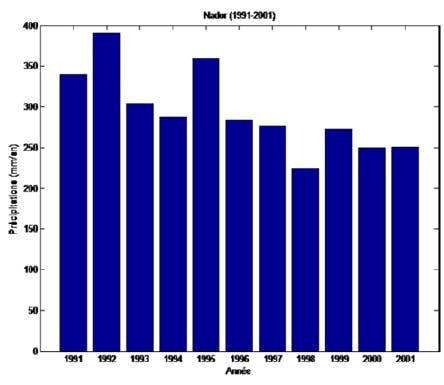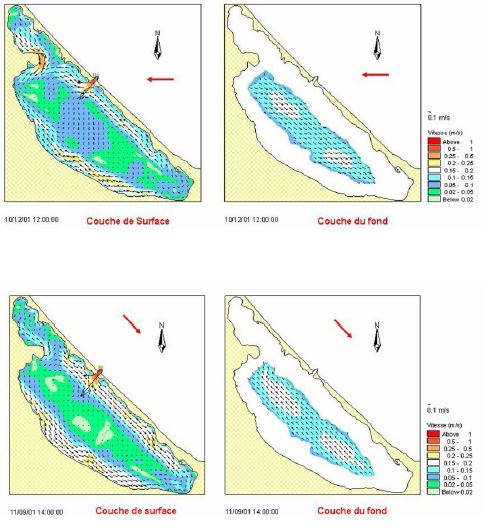8.3 Physical and chemical characteristics of the lagoon
8.3.1 Climatology
Rainfalls: the Nador lagoon climate is part of the eastern Rif climate, which is semi-arid with a temperate to warm winter where the annual variability is particularly marked. Rainfall is low and much irregular, alternating between dry and wet periods. Over the period 1933-1963, the average BouAreg plain rainfall was 401 mm.
Temperature: Monthly air temperature averages ranges from 7 to 17°C in January and from 20 to 28°C in August. The minimum temperature is recorded in January (1°C) and the maximum in August (35°C).
Winds: The wind in the Nador region has two dominant directions: east-northeast to east from May to October and west-southwest to west between November and May.
The most important rivers around the lagoon basin are the Kabayo and Selouane rivers. According to Frisoni et al. (1982), the freshwater volume that reaches the lagoon is evaluated in 40–200.106 m3/year provided by streaming and to 18.106 m3/year provided by groundwater flowing.
There are some water inputs coming from wastewater treatment provided by domestic wastewater city treatment plants of Nador, Beni Ansar and Kariat Arekmane.

Figure 2. Nador lagoon – Average annual rainfall over the period 1991– 2001 (Arid et al., 2005)
8.3.2 Hydrology
Tides: As the general case in the Mediterranean coast of Morocco, the Nador lagoon tide regimen is mainly semi-diurnal (M2 type of period of 12.42 h).
The most common heaves are those coming from east (21.3 percent), east-northeast (15.19 percent) and west (17.37 percent).
Seawater circulation:
Seawater circulation in the Nador lagoon is mainly related to the local dominant winds as shown in

Figure 3. The double-ended zones of this lagoon seem always to be its most confined areas.
Figure 3. Nador lagoon – Three dimensional seawater surface and bottom circulation (Hilmi et al., 2003, Hilmi, 2005).
8.3.3 Physico-chemical characteristics of the water column
Seawater temperature: Seawater temperature generally ranges between 18 and 26°C in winter and 25 to 30°C in summer. In the latter, mainly in July, temperature increase seems to support the metabolic activity of organisms and consequently allows more oxygen consumption in the summer time compared with the winter. The average concentration of dissolved oxygen is 12.4 mg/l in the winter and 4.8 mg/l in the summer.
Salinity: Nador lagoon salinity is typical of marine waters, ranging between 36 to 42‰, with higher values related to the containment areas near Beni Ansar village in the northwest of the lagoon and near the Kariat Arekmane village in the southeast of the lagoon.
Consequently, freshwater inputs coming from these two areas do not have significant influence over salinity. Freshwater is always localized in the northern part of the lagoon, near the lido. 165
Phosphates: Phosphate values vary on average between 0.001 to 0.02 mg/l in July and 0.3 to 0.4 mg/l in March. The highest values were recorded in the area near continental margin, near wastewater treatment plants and near aquaculture sites of Marost Company (up to 4 mg / l).
Nitrites: Nitrite values vary from a low of 0.01 to 0.1 mg/l in winter (March) and from 0.001 to 0.04 mg/l in summer (July). Inland waters are the main sources of nitrite. Even if the values remain very low for the entire lagoon, the highest concentrations were recorded near the continental margin. Irrigation water from the Bou-Areg plain appears as the main sources of this element. Surface waters are relatively richer in nitrite than bottom waters. This reflects the fact that the ammonium-nitrate transformation is usually happening on the water surface.
Nitrates: The maximum values of nitrates were recorded in the lagoon near the continental margin. In general, the nitrate levels in the lagoon are very high; an average of about 0.36 mg/l in the rainy season and 0.21 mg/l in the dry season. Surface waters are much rich in nitrate than bottom waters. Irrigation water from the plain of Bou-Areg and wastewater from Nador city are the main sources of this element.
8.3.4 Physico-chemical characteristics of the sediments
In terms of the hydro-lagoon system, although the freshwater and the transported continental materials during floods are rich in trace elements such as manganese, zinc, copper, lead, etc. (Tesson, 1977; Mahjoubi, 1991), the search of micro-pollutants (heavy metals) in the lagoon did not highlight the presence of these elements in the aqueous phase (Inani, 1995). Indeed, the physical and chemical characteristics of Nador lagoon seawater (including alkaline pH and organic matter abundance) do not favour the presence of these metals in the dissolved phase, which are generally in particulate phase or trapped in sediment by organic matter. Therefore, even if heavy metals seem to be unimportant in the aqueous phase (Inani, 1995), their transfer through the food chain components could have a potential impact in the areas most affected by discharges.